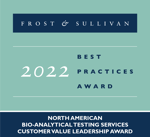As you may know, Inotiv acquired the assets from BioReliance® Genetic Toxicology in July of 2021, and completed the acquisition of Integrated Laboratory Systems, LLC (“ILS”) services in January 2022. Inotiv’s Genetic Toxicology services now support your project with a full battery of validated genetic toxicology in vitro cell-based assays and in vivo assays to meet ICH, OECD, FDA, EPA, and international guidelines. We support standard and tailored services to meet your testing needs.
Genotoxicity assessment has long been an important and required aspect of product development. As a worldwide leader in Genetic Toxicology, Inotiv is uniquely positioned to provide the assays, testing paradigms and expert advice to assist in the safety and hazard assessment of your products in development.
Our scientific staff and state-of-the-art facilities provide the most current and comprehensive genetic toxicology resources available anywhere.
Comprehensive End to End Solutions for Genotoxicity Assessment
Our Genetic Toxicology team has worked with a broad spectrum of test articles and has performed thousands of genetic toxicology studies in accordance with international guidelines. Studies are conducted in full compliance with GLP regulations, or to non-GLP where needed. As your partner, you now have access to a team with years of experience in:
Genetic Toxicology Test Battery
A standard (harmonized) battery of genetic toxicology assays is an integral part of many global regulatory guidelines. Inotiv offers the most comprehensive portfolio of assays and designs to meet all regulations and product types requiring Genetic Toxicology testing.
All assays conform to OECD guidelines (when applicable) and are GLP-compliant.
Assay Categories:
Bacterial Reverse Mutation Assay (Ames assay)
The Ames Test (Bacterial Reverse Mutation test) provides a simple,
straight-forward measure of the mutagenicity of small molecule formulations of pharmaceuticals, cosmetics, flavors & fragrances, consumer products, veterinary products, impurities and more.
At Inotiv, we offer the most comprehensive array of methods, designs, and options for Ames Tests, including:
- Ames Plate Incorporation Method
- Ames Preincubation Method
- Ames Treat and Plate Method
- Ames assays for nitrosamine qualification
In Vitro Cytogenetics
- Chromosomal Aberration Assays
- Options: Human Peripheral Blood Lymphocyte (HPBL), Chinese Hamster Ovary (CHO)
- Micronucleus Assay
- Cells: TK6, HPBL, CHO, A375
- Analysis: Microscopy or Flow Cytometry
- MOA: FISH and CREST
*Also available in EpiDerm™ 3D Reconconstructed Human Skin (RSMN Assay)
The micronucleus assay is ideal for use as a follow up assay to explore mechanism of action (aneugenic or clastogenic) from an initial genotoxicity result. Either FISH or CREST techniques may be used without the need to interrogate additional cells beyond the basic assay design.
In Vitro Mammalian Cell Gene Mutation Assays
- L5178 TK+/- Mouse Lymphoma Assay (MLA)
- CHO/HPRT Assay
In Vivo Cytogenetics
- Micronucleus Assay
- Options: Species: Mouse, Rat
Analysis: Microscopy or Flow Cytometry
- Options: Species: Mouse, Rat
The in vivo micronucleus assay is a short-term cytogenetic assay for detecting agents that induce chromosomal breakage or spindle malfunction. Femoral bone marrow or peripheral blood is evaluated either microscopically or by flow cytometry for the presence of polychromatic erythrocytes containing micronuclei.
Other Genetic Toxicology Services
Genetic Toxicology Screening Assays
Inotiv provides insights through a cost-effective, non-GLP genetic toxicology screening program that is designed to quickly determine the genotoxic potential of your substance. Our approaches include:
- Mini Ames assay
- Microwell and mini in vitro micronucleus assay
- Mini in vitro chromosome aberration assay
- In vitro high content MultiFlowⓇ assay for mode of action predictions
- In vivo Micronucleus and Comet
Rationale and Strategies for In Vitro Screening Assays
Early identification of potential genotoxic issues with candidate compounds is an essential part of a product development process.
Selection of Assays
When designing a screening program, various factors need to be considered including: the purpose of the testing (e.g. prediction of GLP assays or investigation of mechanism of action), how the data will be used, the quantity of test article available, cost and timeline.
High Throughput (HTP) Screening Assays
Inotiv provides testing using the Multiflow™ assay which can determine mode of action and genotoxicity. The Multiflow™ can provide information on which MOA is present therefore providing definitive information on whether or not a substance is genotoxic and whether or not it should be continued for development.
MultiFlow™ is a high-throughput 96-well assay using human TK6 cells. and Litron’s MultiFlow™ DNA Damage Kit. The assay uses a combination of machine learning and global evaluation factor models to predict the clastogenic, aneugenic, or non-genotoxic properties of test articles based on patterns of test article-induced changes in p53, γH2AX, Phospho-Histone H3 biomarkers and polyploidy. This assay is used to predict genotoxic properties as well as Mode of Action (MOA) of test articles in one single assay, a feature which is not found in other screening assays. Moreover this assay provides concurrent analysis of multiple biomarkers (p53, γH2AX, Phospho-Histone H3) and thus avoids the limitations of predictions of a single assay or biomarker. A test compound can be classified as a clastogen, aneugen, or non-genotoxicant. Identification of a clastogenic MOA means that the compound is likely DNA reactive with a linear dose response. No exposure or, at best, very low exposure is considered safe; and further product development may not be advisable. On the other hand, an aneugen MOA means that the compound is likely non-DNA reactive and that there may be a threshold response and a margin of safety that allows for the compound to continue in development. A classification of non-genotoxicant could mean the product is safe for further development. The high through-put design has short turn-around times using minimal amounts of test article. The MOA information can also be used for designing GLP assays in a smarter way to avoid costly and time consuming follow-up assays.
Predictive Screening Assays
These assays are smaller versions of the GLP assays and therefore require much smaller amounts of test article and can be performed in less time and for less money.
QSAR In Silico Mutagenicity Prediction
Inotiv offers Quantitative Structure–Activity Relationship (QSAR) as an in silico method for predicting chemical substances causing adverse effects based on their chemical structures. Our expert rule and statistical-based models include:
- Leadscope®
- CASE Ultra
- OECD QSAR Toolbox
Quantitative Structure Activity Relationship (qSAR) involves in silico methods designed to find relationships between chemical structure and biological activity of compounds from both in vivo and in vitro assays. This tool is a primary step in lead candidate selection and is useful in pharmaceutical development, agricultural and industrial chemical assessment, and impurity analysis. QSAR models include those for bacterial mutagenicity models for ICH M7 guidelines, carcinogenesis, and various types of organ-specific toxicities. Since in silico analyses do not require synthesis of the chemical of interest, they provide a cost and time effective approach to early screening.
Follow-Up Mechanistic Assays
Studies have shown that 29% of marketed drugs contained positive findings in one of the four categories of standard battery assays (bacterial mutation, in vitro mammalian cell gene mutation, in vitro and in vivo cytogenetics). For these reasons, a range of approaches are available to assess the relevance of a positive genotoxicity result. While there are techniques such as QSAR and FISH/CREST to assess whether a positive result is real, if indeed these techniques result in a real positive, follow-up assays can be conducted to further define the biological relevance of the result.
In Vivo Single Cell Gel Electrophoresis “Comet“™ Assay
- Mice and Rat
- Tissues include: peripheral blood, bone marrow, brain, colon, duodenum, jejunum, kidney, liver, lung, nasal cavity, skin, spleen, stomach, testis, uterus
The Comet Assay, also called single cell gel electrophoresis, is a rapid and sensitive technique for accurately analyzing DNA damage (genotoxicity) in individual cells from small molecule formulations of industrial chemicals, consumer products, agrochemicals, and pharmaceuticals. The Comet Assay is a common follow up to a positive in vitro assay (such as the chromosome aberration and/or in vitro micronucleus assay).
The Comet Assay can be used to detect multiple types of DNA damage that are caused by a small molecule test agent. This includes single and double stranded breaks, alkali labile sites, oxidative base damage, and DNA cross-linking.
The Comet assay can detect specific DNA damage and repair, and thus can explore mechanism and mode of action to further investigate the effects of a compound.
At Inotiv, we offer Comet assays in multiple formats including:
- In vivo rodent Comet assays (different dosing regimens are available)
- In vivo Comet assay in combination with in vivo Micronucleus assay
- Comet assay slide evaluations (if the assay is performed at your lab and the slides need to be scored)
- Mobile Comet — we bring the assay to you and can perform in any lab as part of an ongoing toxicology study!
Pig-a In Vivo Gene Mutation Assay
- Rat or mouse peripheral blood with Flow Cytometric Scoring
Pig-a assay is a GLP-validated technique for measuring mutations caused by genotoxic effects of novel drug treatments or chemicals.
Gene mutation assays, like the Pig-a assay, measure the induction of mutations at a specific gene location as opposed to measuring overall DNA damage. This provides an advantage for product development and regulatory decision making.
Clear advantages of the Pig-a Assay include:
- Easily integrates into standard toxicity studies
- Reduces animal use
- Replaces expensive transgenic rodent mutation assays
- Fast, quantifiable results with flow cytometry
The entire Pig-a assay can be performed at Inotiv, or samples can be sent for analysis that can be performed alone or in conjunction with other endpoints (Micronucleus Assay, Comet Assay, Metaphase Analysis, etc.)
Integrated Genetic Toxicology Endpoints and Repeat Dose Studies
In vivo endpoints may be integrated into general toxicology studies with repeat dosing. Endpoints can be evaluated by Flow Cytometry (when available) or manual scoring (microscopy).
Endpoints include: In Vivo Micronucleus, In Vivo Comet, Pig-a
Other Assays
Morphological Transformation
- bhas Cell Transformation Assay
Cytotoxicity Assays
- Neutral Red Uptake Assay
- A549 cells
- 3T3 cells
To learn more about how we can help move your program forward, please contact us to discuss your needs.
Whatever you need, from method development to metabolite ID, our phase-appropriate bioanalytical services help you analyze, answer, and advance.
Access world-class anatomical, clinical, and medical device pathology services, from routine histochemistry, IHC, IF, and ISH to stereology.
Inotiv offers a range of general toxicology studies to evaluate the safety of drugs, medical devices, and other chemicals. We design and conduct studies according to international regulations and our toxicology expertise can help assess potential risks and ensure the safety of your product.



